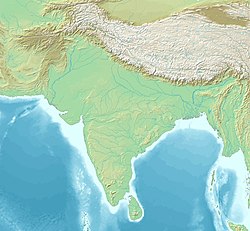Shatial is a transit station with archaeological significance on Karakoram Highway in Gilgit-Baltistan region of northern Pakistan.
| Location | Gilgit-Baltistan, Pakistan |
|---|---|
| Coordinates | 35°31′37″N 73°32′36″E / 35.52694°N 73.54333°E |
Location
editShatial is an important transit station consisting mainly of shops, rest places, and sarais.[1] It is located 60 kilometres (37 mi) west of Chilas in the upper Indus Valley beside the Indus River in Gilgit-Baltistan.[2] Historically it acted as a junction of old routes and byways connecting Swat Valley, Gilgit, Chilas, and Chitral.[3]
Archaeological sites
editAs a historical crossroads, many traders, Buddhist missionaries, Sogdian merchants, and pilgrims passed through Shatial leaving behind graffiti and inscriptions on the rocks. More than 1000 inscriptions and 700 petroglyphs can be found at the Shatial bridge on the Indus River. Iranian merchants left behind over 550 inscriptions dating from third to seventh centuries in the Sogdian language,[2][3] nine in the extinct Bactrian language, and two in Middle Persian and Parthian each.[4] Many of these inscriptions are short, consisting of just the names of the travelers, though in some cases names of two or more family members are also mentioned.[4] Many inscriptions also mention a date, possibly of arrival, but it is unknown whether this refers to the date or year of journey.[4] Nanaivandak, a famous merchant from Samarkand who is a subject in Susan Whitfield's book Life Along the Silk Road,[5] wrote the longest such inscription reading:
Nanai-vandak, the (son of) Narisaf, came on (here) the tenth and have requested the favor from the soul of the holy place Kart (that) I reach Kharvandan very fast and see (my) dear brother in good (health).[3]
These Iranian inscriptions are significant in providing insight on the naming traditions of Sogdians of the time as some of these are theophoric referring to Zoroastrian and other deities.[4] Though these inscriptions do not establish an exact date or period, it is believed that most of them belong to the Sasanian period (224–651 AD).[4]
Scripts and graffiti in ancient Brahmi and Kharosthi languages are found on the rocks revealing that the place also served as a Buddhist shrine. The Buddhist travelers venerated these inscriptions and artwork, particularly a large triptych with drawings of a stupa and Sibi Jataka.[3]
References
edit- ^ "Introducing Shatial". Lonely Planet. Retrieved 21 March 2013.
- ^ a b Fussmann, Gérard; König, Ditte (1997). Die Felsbildstation Shatial. Materialien zur Archaeologie der Nordgebiete Pakistans (in German). Vol. 2. Mainz: Verlag Philipp von Zaber. ISBN 3-8053-2027-2.
- ^ a b c d Neelis, Jason (15 May 2012). "Shortcuts for Transmission of Buddhism". In Alcock, Susan E.; Bodel, John; Talbert, Richard J. A. (eds.). Highways, byways, and road systems in the pre-modern world. Ancient World: Comparative Histories. Vol. 5. Chichester, West Sussex: Wiley-Blackwell. p. 19. ISBN 9780470674253. Retrieved 21 March 2013.
- ^ a b c d e Williams, N. Sims. "The Iranian Inscriptions of Shatial" (PDF). The Journal of the International Association of Sanskrit Studies. 23–24 (Epigraphical and Numismatic Studies): 523–541. ISSN 1023-3881. Retrieved 22 March 2013.
- ^ Whitfield, Susan (1999). Life along the Silk Road. Berkeley: University of California Press. pp. 27–54. ISBN 9780520232143. Retrieved 22 March 2013.
nanaiVandak.
Further reading
edit- Arif, Muhammad (2001). Study of Petroglyphs of Buddhist Period along the Silk Road between Shatial and Khunjerab Pass, Northern Areas, Pakistan (PDF) (PhD). Higher Education Commission Pakistan. Retrieved 15 April 2022.

